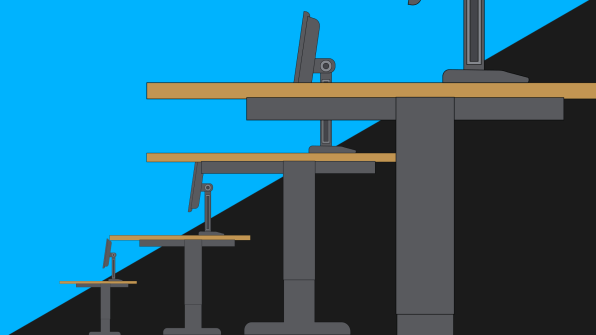Feeling nervous about a big job interview or a company-wide presentation? These small adjustments can help you fake it until you make it.

Most of us have heard about “power posing” and the art of faking confidence by using big arm gestures and open body language. Harvard Professor Amy Cuddy popularized this notion and even argues that by faking it, you can make yourself feel strong and powerful.
If standing like a superhero isn’t enough, there are many other ways to fake confidence. Whether you’re at a high-stakes job interview or presenting at a meeting with your coworkers, if you’re feeling nervous, try the following six techniques to create the illusion of confidence.
You’ll look confident—and as you try these strategies, you’ll come to feel more confident.
1. MAKE EYE CONTACT
The first way to simulate confidence is to use the power of your eyes.
Over 70% of our sensory receptors are in our eyes. The eyes dominate all the senses—they are far more powerful than all our other senses put together. So when you look people in the eye, they are compelled to look at you and subordinate everything else to that connection with you. They cannot escape your gaze.
If you are in a meeting with your boss, target your eye contact to her, and she’ll be less likely to look away or be distracted. Similarly if you are speaking at a team meeting, make one-on-one eye contact with each participant in the room. As you do so the whole room will feel the power of your gaze and be centered on you.
This control of the room will give you the aura of a supremely confident person.
2. SIT AND STAND TALL
The second way to fake confidence is to be as tall as you can.
If you sit and stand up straight, you will project a heightened version of yourself (literally!) and you’ll look confident no matter what you’re feeling inside. You’ll also appear to be in the “ready” position–ready to speak, respond, and contribute confidently to the discussion. In contrast, if you look down, slouch, or twist your body, you’ll appear less centered and less certain.
If you have a choice between standing and sitting, choose to stand. When you are giving a presentation to a room full of people, or when you are on a conference call, standing up will not only impress those in the room, it will also put more authority in your voice.
3. BE STILL
A third way to look confident is to keep your body still and avoid moving randomly or excessively.
If you have lots of busy gestures or flyaway movements, you’ll likely project confusion, nervousness, anxiety, or lack of preparedness. So avoid fleeting movements of your head, busy arm gestures and small wrist gestures, leg movements or nervous twitches. Also avoid touching yourself and grooming gestures like fixing your hair. By foregoing such random or nervous gestures you will make every movement count and let the audience see your confidence and poise.
4. SLOW YOUR PACE
A fourth way to appear confident is to slow the speed at which you speak.
We tend to rush when we’re nervous and rushing makes our audience aware that we are not comfortable, and that we’re anxious to get through our speaking. When you slow your pace, you convey just the opposite impression: that you are comfortable speaking, that your ideas are important to you, and that you want your audience to hear and appreciate your ideas. There are two ways to slow down. First, change your rate of word delivery. Lengthen the time you give to every word. Second, increase the length of your pauses. This will tell your audience you want them to absorb each idea, and you’re giving them time to do so.
5. GROUND YOUR VOICE
A fifth way to project confidence is to speak in a lower pitch.
Those deeper registers will give your voice a quality that suggests you are strong, formidable, and leader-like, even though you may be feeling insecure.
By consciously thinking of deepening your voice you will avoid the flyaway vocal patterns that often come with nervousness. Indeed, even when not nervous some folks have high voices, squeaky voices, or voices that lift off at the end of sentences. All these patterns embody a vocal style that suggests a lack of confidence (even though these vocal patterns may be vestiges of our youth).
So if you are speaking in a meeting, consciously try to ground your voice. Think gravitas, which means seriousness or sobriety. Think of gravity pulling your voice lower. And when you do, your words will resonate with more significance, and you will sound far more confident than when your voice was higher.
6. ARTICULATE YOUR WORDS
Finally, you can simulate confidence by clearly articulating your words.
We’ve all heard speakers who devalue what they say by slurring over words. You’ll sound more confident if you put commitment and energy behind your words. Speak so your audience understands every word you deliver. Mumbling will make you come across as insecure and unwilling to put yourself fully into what you’re saying.
The secret to good articulation is not to let your energy fall off at the ends of words or the ends of sentences. Stay with your ideas, and let them resonate fully with your audience.
These six ways of projecting confidence–even when you may have the jitters–will help you convey a powerful image of yourself. And the added bonus is that when you use these techniques, you will actually become more confident.
- 7:00 AM
Scientists have good news and bad news about sit-stand desks
A new meta-study analyzed all the research on sit-stand desks. They found that while standing desks probably won’t help you lose weight, there are other reasons to buy one.
If you’ve been following the trickle of research coming in on sitting vs. standing desks, you know conclusions are murky. Sitting will kill you! But standing will kill you, too! So what about those desks that let you sit or stand? Are they the answer to feeling better at work?
Yes, they are. Researchers recently analyzed 53 separate studiesconducted on sit-stand desks and discovered that, while sit-stand desks certainly aren’t a panacea–and they probably won’t shed inches off your waistline–they can absolutely have a positive impact on your health and well-being.
The project was led by April Chambers, research assistant professor at the University of Pittsburgh’s Department of Bioengineering. She tells me that she began getting interested in sit-stand desks because much of her work was in occupational injury prevention for people who were on their feet all day, like nurses and retail workers. So she’d seen first-hand that these active jobs took a real toll on people’s bodies.
“Sitting all day is bad for you–and standing all day is as well,” says Chambers, who explains that standing all day can create swelling in your feet, pain, and vascular issues.

So Chambers and her collaborators rounded up all research on the happy medium between sitting and standing, sit-stand desks. And they analyzed the papers for their broad implications on behavior, physiological, work performance, psychological, discomfort, and posture.
What did they find? First, the bad news. “When sit-stand desks first hit the market, a lot of people grabbed hold of them as a way to lose weight,” says Chambers.
No doubt, this was driven by messaging that promoted them as “fit”and sometimes had infomercial-style claims of “transforming” your life. “The science is pretty clear,” says Chambers. “You may be able to use them as a weight management aid, but as far as a quick weight loss tool, you’re not going to see those instant results.”
However, just about every other finding in their meta-review on sit-stand desks was positive. These desks do change people’s behavior; just having one available does encourage people to stand more often. In other words, they work as intended. Examining the actual effects on someone’s body, some sit-stand desks users were found to have slightly lower blood pressure, and their heart rates was elevated between 7 and 13 beats per minute while standing, which is considered good for heart health.
But the best news was regarding comfort in general. “The really neat fact for us was we saw bigger improvements across the literature in decreasing discomfort,” says Chambers. Most promising was a small group of niche studies that found people with lower back pain saw real improvements from using sit-stand desks.
Since sit-stand desks were found to have no negative impacts on worker productivity, performance, or mood, Chambers thinks that sit-stand desks are a net positive for most people. “Even though the physiological things we found were mild changes, depending on who you apply those changes to, it may make a big difference in their health,” says Chambers. “I’m sure no one would complain in a minor improvement in their health.”
Chambers believes the next step is deciphering how to optimize the day-to-day use of sit-stand desks, figuring out the best practices for how long people should switch positions to maximize the positive benefits. Right now, people self-regulate these behaviors, which may not be the best approach when it comes to comfort. At least one major furniture company is considering how to automate it.
“The issue is, once you’re uncomfortable, it’s hard to get comfortable again,” says Chambers. “If we can use the desk as a way to delay that discomfort from coming on, that’s the real key to it.”




